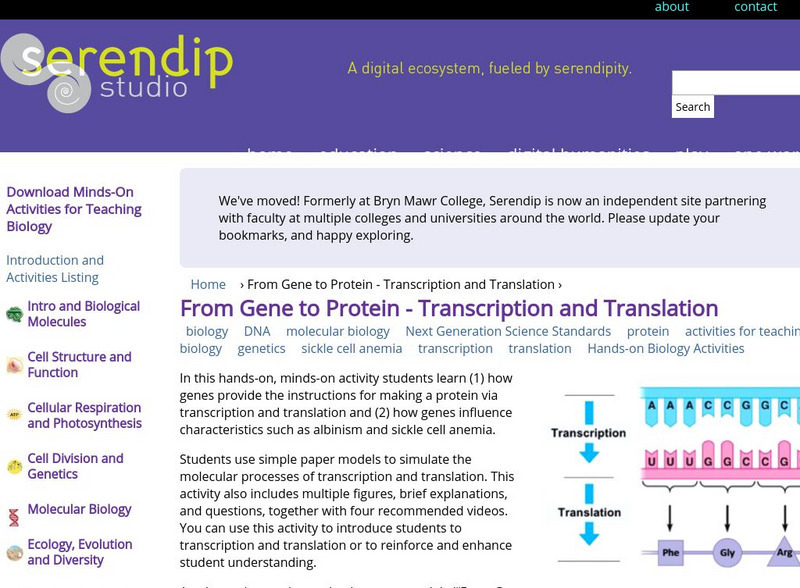Towson University
Mystery of the Crooked Cell
Can your class solve the Mystery of the Crooked Cell? Junior geneticists collaborate to learn about sickle cell anemia in a fascinating lesson plan. The included materials help them to examine the genetic factors behind the disease...
Towson University
Mystery Disease
How did scientists determine the cause of illness before technology? Science scholars play the role of medical researcher in an engaging guided inquiry activity. Using observations, technical reading, and Punnett squares, learners...
Curated OER
Exploring Structure and Function in Biological Systems
Students examine different levels of organization in biological systems for structure and function relationships. In this biological systems lesson, students use Internet resources to look at structure and function in the eye, the...
Curated OER
The Human Genotype
Six different chromosome activites introduce biology aces to heredity, chromosomal abnormalities, sex-linked traits, and the human genome. The hands-on activites are fairly simple for the teacher to prepare and will prove to be both...
Personal Genetics Education Project
Protecting Athletes with Genetic Conditions: Sickle Cell Trait
Should school and professional teams test athletes for sickle cell trait? Will it protect them by providing knowledge or lead to discrimination by not allowing them to participate in sports? After learning about this genetic disorder,...
Curated OER
Allele Frequencies and Sickle Cell Anemia Lab
Students investigate how selective forces like food, predation and diseases affect evolution. In this genetics lesson, students use red and white beans to simulate the effect of malaria on allele frequencies. They analyze data collected...
Serendip
From Gene to Protein - Transcription and Translation
Learners identify the different steps involved in DNA transcription. In this genetics lesson, pupils complete a worksheet and model the translation process with a paper chain activity. They watch a video on sickle cell anemia and explain...
Curated OER
The Electrophoresis of Human Hemoglobin
High schoolers are presented with a scenario that requires them to electrophoreses human hemoglobin samples in order to confirm a diagnosis of sickle cell anemia and/or to determine whether individuals in the scenario are carriers of the...
Howard Hughes Medical Institute
A Lesson on the Nature of Science
If you are looking for a great way to present natural selection in humans, look no further. This handout is intended to accompany the 14-minute video The Making of the Fittest: Natural Selection in Humans, which can be found on the...
Give and Let Live
Blood and Transplant: Blood
Why is blood donation so important, anyway? Science and health classes across multiple grades benefit from an in-depth look into the need for and process of blood donation. With an emphasis on presenting the topic in a non-threatening...
Serendip
From Gene to Protein via Transcription and Translation
DNA carries the codes for creating just the right protein. A well-designed lesson leads pupils through the process from start to finish and everywhere in between. Guiding questions with supporting video help scholars understand the...
Curated OER
Problem Solving: Dots, Symbols, Words and Proteins
Students use symbols and dots to investigate the amino acids in a protein. In this problem solving lesson plan, students use dots and symbolic analogies to solve problems using the IDEAL problem solving method which includes identifying...
Curated OER
Bioethics: Debates in Human Genetics
Young scholars, in groups, research and prepare a debate regarding various bioethical situations. After the debates, each student prepares a ortfolio outlining their own personal opinions.
Curated OER
Developing a Pedigree of a Family Tree
Students create a family pedigree as a product of independent investigation. They learn the symbols used in pedigrees, as well as the usefulness in tracking genetic disorders. During cooperative learning activities, students learn to...
Curated OER
Improving Literacy in the Biology Classroom via Genetic Disorders
Students read, write and reflect on Science articles, this approach will promote both literacy and critical thinking skills. Critical thinking skills learned in the science classroom from these activities will impact students in many...
Curated OER
Monohybrid Punnetr Squares
Students explore Punnett squares and illustrate specific genotypic and phenotypic genetic outcomes. After a class discussion, students predict the probability of a specific trait being passed on by using Punnett squares. They reveal the...
Curated OER
Rhythm And Sound 2
High schoolers review the concept of rhythm and this lesson plan looks at some specific sound devices in the study of music. They focus on assonance, consonance, and alliteration. Students define the concept of rhythm and give poetry as...
Curated OER
The Electrophoresis of Human Hemoglobin
High schoolers analyze different types of hemoglobin. They use the technique of agarose gel electrophoresis to separate human hemoglobin molecules according to their electrical charge, size, and/or shape. Students relate the migration...
University of Washington
Genome Sciences Education Outreach: Sickle Cell Anemia [Pdf]
Students will use a Sickle Cell Anemia case study to learn about allele frequencies, genetics, and molecular biology.
Bryn Mawr College
Serendip: From Gene to Protein Transcription and Translation
Brief text summary of what students learn in the Dragon Genetics II lab along with links to download Student Handouts in PDF and Word formats, and Teacher Preparation Notes in PDF format. Students use paper models to learn transcription...


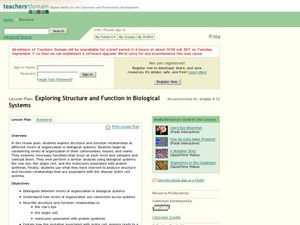


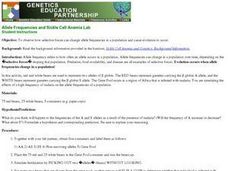


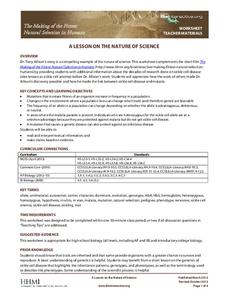




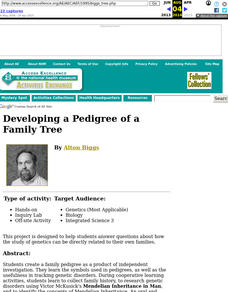


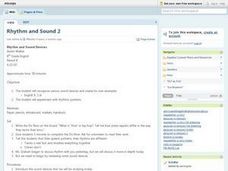

![Genome Sciences Education Outreach: Sickle Cell Anemia [Pdf] Lesson Plan Genome Sciences Education Outreach: Sickle Cell Anemia [Pdf] Lesson Plan](https://d15y2dacu3jp90.cloudfront.net/images/attachment_defaults/resource/large/FPO-knovation.png)
